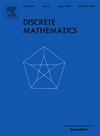The king degree and the second out-degree of tournaments
IF 0.7
3区 数学
Q2 MATHEMATICS
引用次数: 0
Abstract
In a digraph, the second out-degree of a vertex x, denoted by , is the number of vertices y such that , where is the length of the shortest xy-directed path, if it exists. It is obvious that the sum of the first out-degrees of the vertices in a digraph is nothing but the number of its arcs. Unlike the first out-degree, the summation of the second out-degrees of the vertices in a digraph is not constant with respect to the number of vertices and arcs. In this paper, we characterize, as a function of some integer n, the values that can be the summation of the second out-degrees of the vertices in a tournament of order n. Throughout the paper, we use the new concept of king degree in order to settle the problem. The king degree of a vertex x is the number of vertices that can be reached from x by a directed path of length at most 2. Several open problems are introduced in the last section of the paper.
比赛的王度和次出度
在有向图中,顶点x的第二次出度,用d++(x)表示,是顶点y的个数,使得d+(x,y)=2,其中d+(x,y)是最短的x向路径的长度,如果它存在的话。很明显,有向图中顶点的第一个外度之和就是它的弧的数量。与第一个出度数不同,有向图中顶点的第二个出度数的总和对于顶点和弧的数量不是恒定的。在本文中,我们用整数n的函数来描述n阶比武中顶点的二次出度之和的值。在整篇文章中,我们使用王度的新概念来解决这个问题。顶点x的王度是指从x出发,通过长度不超过2的有向路径到达顶点的个数。最后介绍了几个有待解决的问题。
本文章由计算机程序翻译,如有差异,请以英文原文为准。
求助全文
约1分钟内获得全文
求助全文
来源期刊

Discrete Mathematics
数学-数学
CiteScore
1.50
自引率
12.50%
发文量
424
审稿时长
6 months
期刊介绍:
Discrete Mathematics provides a common forum for significant research in many areas of discrete mathematics and combinatorics. Among the fields covered by Discrete Mathematics are graph and hypergraph theory, enumeration, coding theory, block designs, the combinatorics of partially ordered sets, extremal set theory, matroid theory, algebraic combinatorics, discrete geometry, matrices, and discrete probability theory.
Items in the journal include research articles (Contributions or Notes, depending on length) and survey/expository articles (Perspectives). Efforts are made to process the submission of Notes (short articles) quickly. The Perspectives section features expository articles accessible to a broad audience that cast new light or present unifying points of view on well-known or insufficiently-known topics.
 求助内容:
求助内容: 应助结果提醒方式:
应助结果提醒方式:


